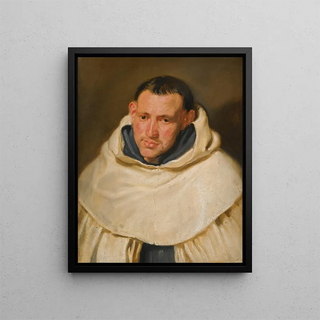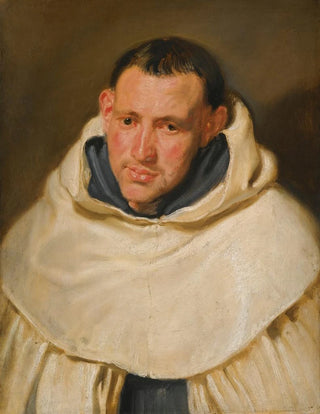Art print | Portrait of a Carmelite monk head and shoulders - Antoine van Dyck


View from behind

Frame (optional)
In the fascinating world of baroque art, the "Portrait of a Carmelite monk head and shoulders" by Antoine van Dyck stands out for its emotional depth and technical mastery. This work, created in the 17th century, embodies both spirituality and the finesse of a time when the portrait became a means of personal expression and social representation. By contemplating this art print, the viewer is immediately transported into the monk's intimacy, whose enigmatic gaze seems to tell a story far beyond the simple features of his face. The subtle light caressing his face and the delicately worked shadows create an atmosphere of reflection, inviting contemplation on human nature and spiritual quest.
Style and uniqueness of the work
Van Dyck's style is characterized by a harmonious balance between realism and idealization. In this portrait, every detail is carefully rendered, from the fabric of the monk's robe to the nuances of his complexion. The color palette, dominated by warm and earthy tones, evokes a sense of serenity, while the contrast between light and shadow highlights the psychological depth of the subject. What makes this art print particularly singular is the way van Dyck manages to capture the very essence of his subject. The monk, far from being a simple religious figure, appears as a man of faith, whose wisdom and contemplation shine through his expression. The chiaroscuro technique, so dear to artists of his time, is used here with mastery, giving the work an almost sculptural dimension.
The artist and his influence
Antoine van Dyck, a pupil of Rubens, is one of the greatest portraitists of his era. His influence on European art is undeniable, marking a transition toward a more personal and intimate style. Settling in London, he became the court painter, and his approach to portraiture influenced many contemporary and future artists. Van Dyck knew how to combine the grandeur of nobility with the simplicity of more humble subjects, such as this Carmelite monk, thus revealing a universal humanity. His work bears witness

Matte finish

View from behind

Frame (optional)
In the fascinating world of baroque art, the "Portrait of a Carmelite monk head and shoulders" by Antoine van Dyck stands out for its emotional depth and technical mastery. This work, created in the 17th century, embodies both spirituality and the finesse of a time when the portrait became a means of personal expression and social representation. By contemplating this art print, the viewer is immediately transported into the monk's intimacy, whose enigmatic gaze seems to tell a story far beyond the simple features of his face. The subtle light caressing his face and the delicately worked shadows create an atmosphere of reflection, inviting contemplation on human nature and spiritual quest.
Style and uniqueness of the work
Van Dyck's style is characterized by a harmonious balance between realism and idealization. In this portrait, every detail is carefully rendered, from the fabric of the monk's robe to the nuances of his complexion. The color palette, dominated by warm and earthy tones, evokes a sense of serenity, while the contrast between light and shadow highlights the psychological depth of the subject. What makes this art print particularly singular is the way van Dyck manages to capture the very essence of his subject. The monk, far from being a simple religious figure, appears as a man of faith, whose wisdom and contemplation shine through his expression. The chiaroscuro technique, so dear to artists of his time, is used here with mastery, giving the work an almost sculptural dimension.
The artist and his influence
Antoine van Dyck, a pupil of Rubens, is one of the greatest portraitists of his era. His influence on European art is undeniable, marking a transition toward a more personal and intimate style. Settling in London, he became the court painter, and his approach to portraiture influenced many contemporary and future artists. Van Dyck knew how to combine the grandeur of nobility with the simplicity of more humble subjects, such as this Carmelite monk, thus revealing a universal humanity. His work bears witness






